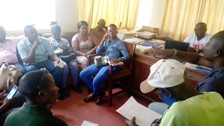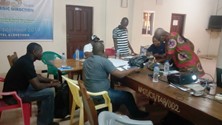- By Lydia Fink
- 5. May 2021
- 0 Comments
Sierra Leone is still far from establishing a reliable data base on its land mass with verifiable boundaries between parcels of land. Thus, household families, villages, communities are frequently in conflict of boundary disagreements. These conflicts can prolong for many years, sometimes resulting in bloody confrontation, hostilities, and loss of life.
The Land for Life (LfL) initiative is engaged in ‘dialogue for change’ as its main intervention strategy. This is done by conveying constructive dialogue processes between stakeholders involved in the various multi-actor partnership structures established in four operational districts across the country. Within the four operational districts, land committees in 12 chiefdoms and 40 communities have been formed.
The LfL-Consortium organization Network Movement for Justice and Development (NMJD) is rolling out the LfL Initiative in Kenema district. Tissor community, located about three miles out of Kenema city, is one of the ten communities where the initiative is engaging on land related matters.
Over decades, Tissor and its bordering Hangha community have had disagreements over the exact position of the boundary that divides the two villages. Like many other communities, boundary features between these two communities have been washed off or distorted by ecological changes. It could be a rock that has been displaced by erosion or road construction or a stream which has been diverted by mining or other human actions.
As it can be overserved in many regions, such inter-community conflicts tend to intensify when an investment company expresses interest to acquire land within the communities. Recently, a US based investment entity called SPIRE initiated a large-scale land-based agribusiness investment in Kenema: the Aqua and Agriculture Based Community Development Export (ABCDE) Project.
In the process of establishing ownership of the land around in and around the concession area, the boundary dispute between the two communities escalated into a violent conflict. The incident received the attention of the police force, giving cause to establish deployment in the area. The police were able to prevent further escalation of the conflict and to stop the violence.
However, this approach was not sustainable. During one of his regular visits, the LfL district facilitator in Kenema identified the need for a constructive dialogue between stakeholders of the two communities. The matter was reported to the Kenema District Multi-Stakeholder Platform (DMSP). The DMSP initiated engagement with top land governance officials in Kenema city. A cross section of the executive paid a visit to the two communities for a more detailed understanding of the matter. Beyond this, the DMSP is discussing the option to facilitate a large town hall meeting and a mediation session for representatives of the two communities. The goal is to identify the true administrative boundaries between the two communities and to restore peace. This will help the two communities to continue living peacefully side by side. Instead of fragmenting over boundary disputes the communities have a more united position to engage with the investor on the initiated agribusiness project to meaningfully represent community interests.


Members of the district multi-stakeholder platform are discussing on how to move forward.
